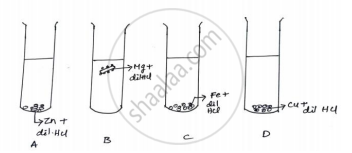Advertisements
Advertisements
प्रश्न
Give reasons:
Platinum, gold and silver are used to make jewellery.
Give a reason for the following:
Silver, gold and platinum are used to make jewellery.
उत्तर
- Gold, silver, and platinum are the least reactive metals. They do not react with air, water, acids, alkalis, or other gases in the environment, so their shine lasts for years.
- Due to their bright lustre and resistance to corrosion, gold, silver, and platinum are used to make jewellery.
APPEARS IN
संबंधित प्रश्न
The chemical reaction involved in the corrosion of iron metal is that of:
(a) oxidation as well as displacement
(b) reduction as well as combination
(c) oxidation as well as combination
(d) reduction as well as displacement
What is meant by galvanisation? Why is it done?
State two conditions for the rusting of iron.
In one method of rust prevention, the iron is not coated with anything. Which is this method?
Fill in the following blank with suitable word:
The corrosion of iron is called ................
Fill in the following blank with suitable word:
The process of depositing a thin layer of zinc on iron articles is called .............
Explain why, through aluminium is more reactive than iron, yet there is less corrosion of aluminium when both are exposed to air.
What is corrosion?
Name any two metals which do not corrode easily.
What are the special properties of stainless steel?
A common metal which is highly resistant to corrosion is:
(a) iron
(b) copper
(c) aluminium
(d) magnesium
In stainless steel alloy, iron metal is mixed with:
(a) Cu and Cr
(b) Cr and Ni
(c) Cr and Sn
(d) Cu and Ni
A metal X which is resistant to corrosion is produced by the electrolysis of its molten oxide whereas another metal Y which is also resistant to corrosion is produced by the reduction of its oxide with carbon. Metal X can be used in powder form in thermite welding whereas metal Y is used in making cathodes of ordinary dry cells.
(a) Name the metals X and Y.
(b) Which of the two metals is more reactive : X or Y?
(c) Name one ore or metal X. Also write its chemical formula.
(d) Name one ore or metal Y. Also write its chemical formula.
(e) Name one alloy of metal X and one alloy of metal Y.
Mention two uses of the following metals and non-metals
Iron
Corrosion can be an advantage in some case.Explain ?
Observe the following picture a write down the chemical reaction with the explanation.

Write scientific reasons.
Lemon or tamarind is used for cleaning copper vessels turned greenish.
Complete the process of iron rusting by filling the blanks. Suggest a way to prohibit the process.
The iron rust is formed due to........................... reaction. Different
regions on iron surface become anode and cathode.
Reaction on anode region :
`F_e(s) → Fe^(2+) (aq) +2e^-`
Reaction on anode region :
`O_2(g) + 4H^+(aq) +............................ → 2H_2 O (l) `
When Fe2+ ions migrate from anode region they react with ................... to form Fe3+ ions.
A reddish coloured hydrated oxide is formed from ............... ions. It is called rust.
`2Fe_(3+) (aq) + 4H_2O(l) → ................. + 6H_+(aq) `
A way to prevent rusting ..................................................................
What is done to prevent corrosion of metals?
Answer the following question:
What is corrosion? Do gold ornaments corrode? Justify.
What is "rusting"? Describe with a labelled diagram an activity to investigate the conditions under which iron rusts.
Give reason.
An iron article should be given a coat of paint
Give a reason why rust turns moist red litmus blue.
Write a short note on Alloying.
_______ forms a green colour in the water.
Stainless steel is an alloy of _______.
When one of the metals in an alloy is mercury the alloy is called _______.
Find the odd one out and give its explanation.
Write the name.
Method used to prevent corrosion of copper.
Write scientific reason.
Anodization method is useful for prevention of the corrosion of the aluminium.
Write a molecular formula for rust.
Observe the following diagram and write answers.

- Name the method.
- Explain the method.
- Give two examples of this method.
Galvanisation is a method of protecting iron from rusting by coating it with a thin layer of ____________.
The diagram shows the reaction between metal and dil. acid.

What is the reason for different behaviour of Mg in test tube B?
Generally, when metals are treated with mineral acids, hydrogen gas is liberated but when metals (except Mn and Mg), treated with HNO3, hydrogen is not liberated, why?
| A process of forming a thick oxide of aluminium when aluminium is exposed to air. This coat makes it resistant to corrosion. Resistance can be improved by making a layer of oxide thinker. In this technique, the aluminium article is the anode, and the electrolyte is sulphuric acid. The anode reaction results in the formation of a black-coloured film of aluminium oxide on the anode. By putting appropriate dyes in the electrolytic solution, both coloured surface with the decorative finish is achieved. Kitchen articles like anodised such as pressure cookers, pans and frames of sliding windows are applications of this technique. |
- Name the anode and electrolyte used in this technique.
- How can we make aluminium articles made resistant to corrosion?
- Name the technique used to coat the aluminium articles.
